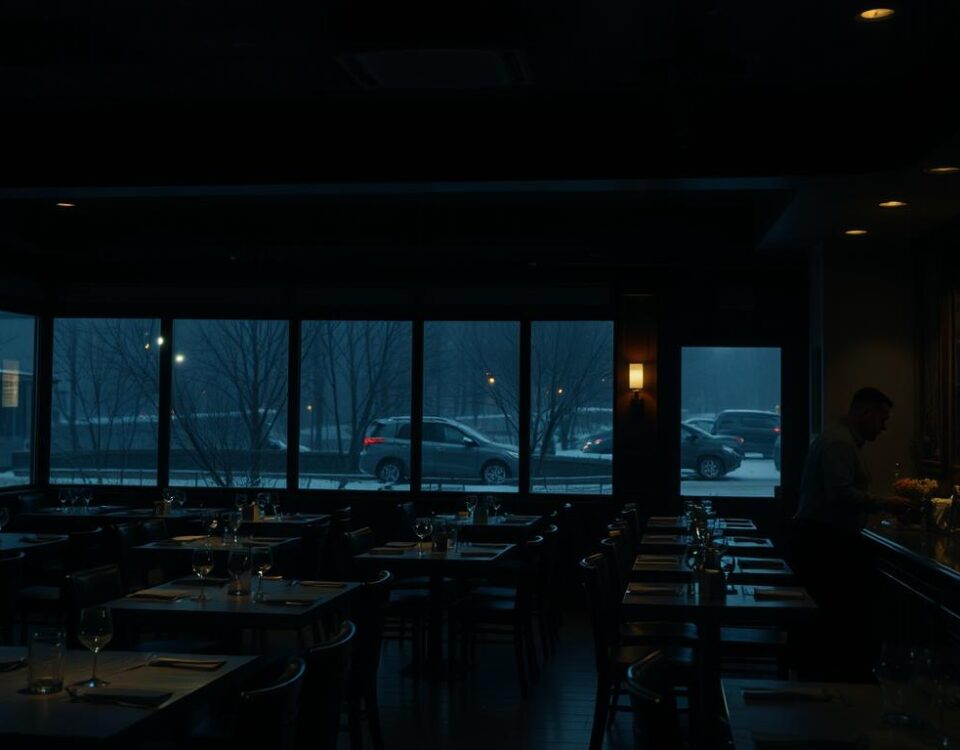
DoorDash vs Uber Eats for Delivery: 4 Mistakes Restaurants Make When Choosing a Platform
October 13, 2025Imagine turning your culinary passion into a thriving business that attracts foodies from all over the city. For many aspiring restaurateurs, this dream becomes a reality, but the journey can be daunting. Did you know that about 60% of new restaurants fail within the first year? The high failure rate is often due to a lack of planning and industry knowledge.
To succeed in the competitive food service industry, you’ll need a solid foundation and a well-executed plan. I’ll guide you through the comprehensive process of starting your restaurant from scratch, covering everything from initial concept development to your grand opening day.
By following my step-by-step approach, you’ll be able to navigate the challenges of restaurant entrepreneurship and turn your culinary dreams into a profitable business reality.
Key Takeaways
- Understand the complexities of launching a successful restaurant business.
- Learn how to evaluate your restaurant concept and target market.
- Create a solid foundation for long-term success.
- Avoid common pitfalls that cause many new restaurants to fail.
- Gain practical insights into the realities of restaurant ownership.
The Reality of Starting a Restaurant Business
The restaurant industry is highly competitive, and understanding its realities is crucial for success. Starting a restaurant business involves a multitude of challenges that can impact its viability and long-term success.
Understanding the Restaurant Industry Landscape
The restaurant industry is a complex and dynamic market. To succeed, it’s essential to understand the current landscape, including consumer trends, competitive pressures, and economic factors. Market research plays a critical role in this process, helping you identify opportunities and potential pitfalls.
Common Challenges and Success Rates
New restaurant owners face numerous challenges, from managing cash flow to staffing issues and competitive pressures. Common mistakes include undefined restaurant concepts, poor employee management, and insufficient start-up capital. Understanding these challenges and the typical success rates in the restaurant industry can help you approach your business with realistic expectations.
| Challenge | Impact on Business |
|---|---|
| Undefined restaurant concept | Lack of clear identity, confusing customers |
| Poor employee management | High staff turnover, poor service quality |
| Insufficient start-up capital | Cash flow problems, inability to invest in marketing |
By understanding these challenges and learning from successful restaurants, you can develop strategies to overcome them and position your restaurant business for long-term success.
Developing Your Restaurant Concept
Developing a restaurant concept that stands out involves identifying a unique idea and analyzing your target market. This process is crucial for creating a dining experience that resonates with your customers and sets your business apart from the competition.
Identifying Your Unique Restaurant Idea
To start, you need to identify what makes your restaurant different. Consider what type of cuisine you want to serve and what kind of atmosphere you want to create. Your unique restaurant idea should be based on your passions, skills, and market demand. For instance, you might specialize in sustainable, locally-sourced ingredients or focus on a specific cultural cuisine that is underrepresented in your area.
Types of Restaurant Concepts to Consider
There are various restaurant concepts to consider, including fine dining, casual eateries, fast food, and specialty restaurants. Each concept has its own unique characteristics and caters to different demographics. For example, Generation Z and Millennials tend to prefer fast-food and quick-service options, while Baby Boomers can afford upscale restaurants. Understanding these preferences is key to choosing the right concept for your target market.
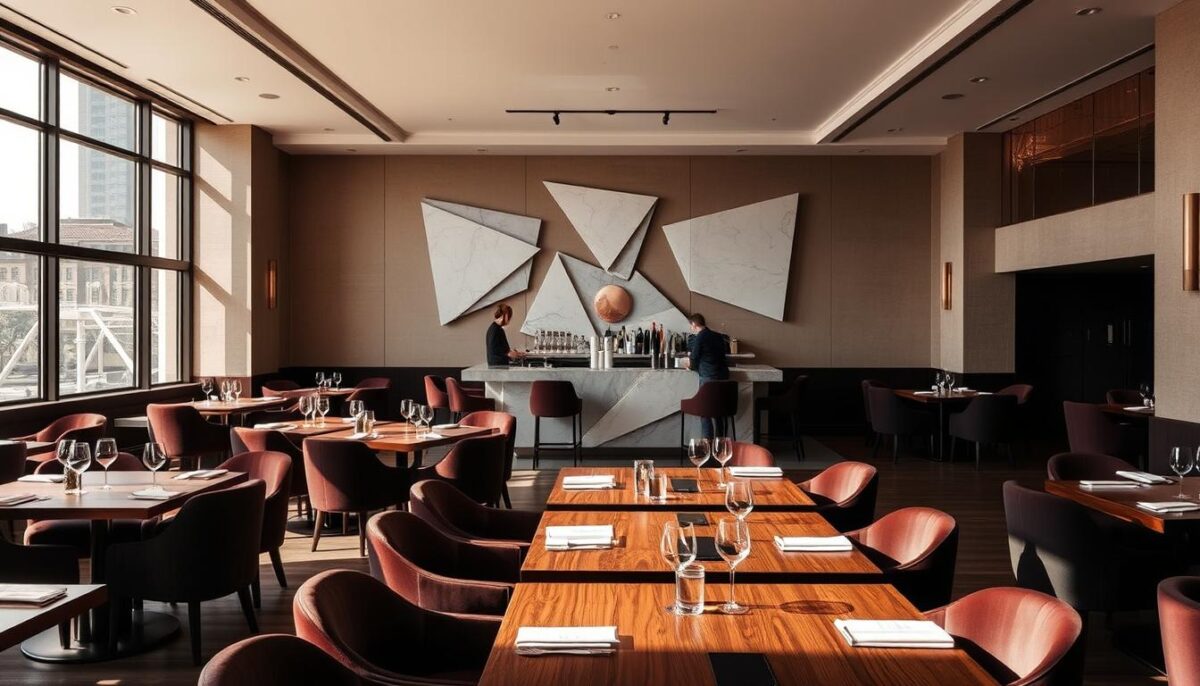
Analyzing Your Target Market
Analyzing your target market involves understanding demographic factors such as age, income, and dining habits. You can conduct market research through surveys, focus groups, and competitive analysis to gain insights into your target audience. Creating customer personas based on your research will help you make informed decisions about your menu, pricing, and marketing strategies. It’s also important to validate your target market assumptions to ensure your restaurant concept meets their needs and preferences.
- Understand the demographics and psychographics of your target market.
- Conduct thorough market research to inform your restaurant concept.
- Create customer personas to guide your business decisions.
- Validate your target market assumptions before launching your restaurant.
Creating a Comprehensive Restaurant Business Plan
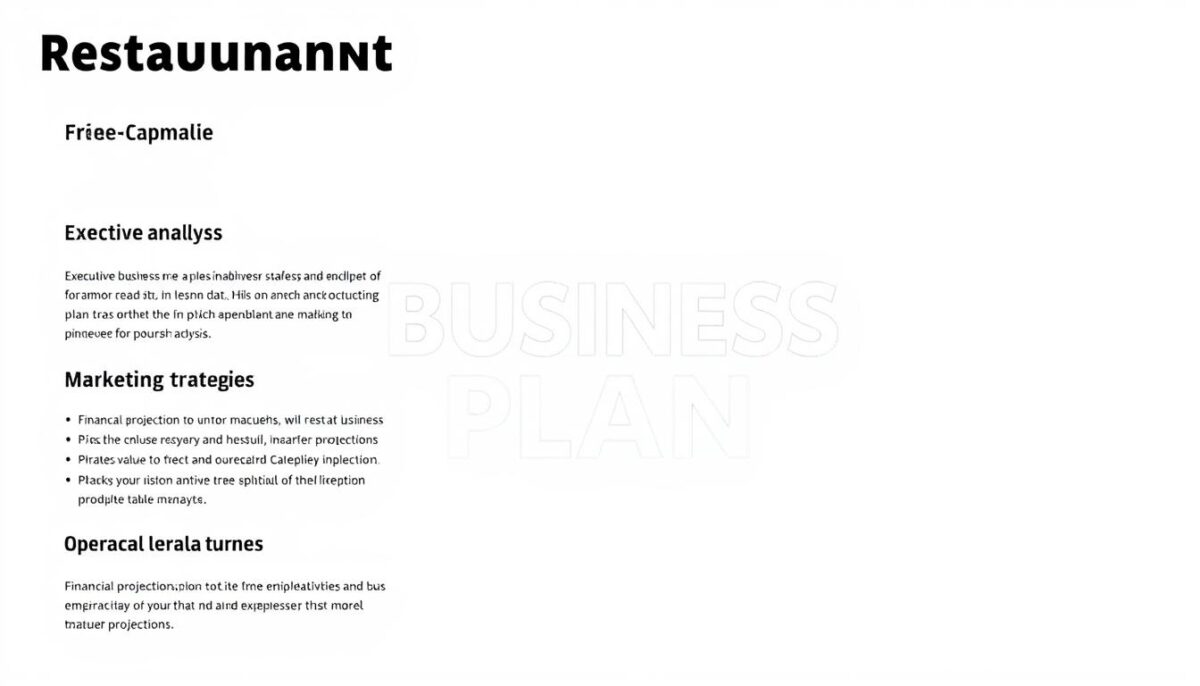
Crafting a comprehensive restaurant business plan is crucial for turning your culinary vision into a successful reality. A well-structured plan serves as a roadmap, guiding your decisions and helping you secure funding.
Executive Summary and Company Overview
Your executive summary should provide a concise overview of your restaurant concept, mission statement, and objectives. The company overview should detail your restaurant’s structure, ownership, and key team members. This section sets the tone for your entire business plan, so it’s essential to make a strong impression.
Market and Competitor Analysis
Conducting a thorough market and competitor analysis is vital for understanding your target audience and the competitive landscape. This involves analyzing demographic data, consumer trends, and the strengths and weaknesses of your competitors. By doing so, you can identify opportunities to differentiate your restaurant and attract a loyal customer base.
Financial Projections and Funding Requirements
Creating realistic financial projections is a critical component of your business plan. This includes forecasting sales, estimating startup costs and operating expenses, and conducting a break-even analysis. I’ll guide you through creating detailed financial projections that cover startup costs, revenue forecasts, and a breakdown of expenses. You’ll learn how to determine your funding requirements and identify the most appropriate financing sources for your restaurant venture.
Some key aspects to consider when creating your financial projections include:
– Developing a sales forecast based on factors like seating capacity and average check size
– Calculating your break-even point to evaluate the financial viability of your concept
– Creating a startup budget that covers initial costs, from leasehold improvements to equipment purchases
– Projecting labor costs, food costs, and overhead expenses to develop a sustainable financial model
Calculating Startup Costs for Your Restaurant
Understanding the financial requirements for launching a restaurant is crucial for its success. When starting a restaurant, it’s essential to have a clear picture of the initial investment required to get the business off the ground.
Initial Investment Requirements
The initial investment for a restaurant includes various costs such as lease or purchase of a location, equipment, furniture, and initial inventory. It’s crucial to create a detailed list of these expenses to determine the total startup capital needed. This initial outlay can be substantial, and understanding these costs helps in planning and securing the necessary funding.
Ongoing Operational Expenses
Once the restaurant is operational, there are ongoing expenses to consider, including food supplies, staffing, utilities, and marketing. These operational costs can vary from month to month, making it essential to establish a flexible budget that can accommodate fluctuations. Effective management of these expenses is key to maintaining profitability.
Creating a Realistic Budget
To create a realistic budget, you need to consider both the initial startup costs and ongoing operational expenses. Here are some key steps to follow:
- Estimate your monthly operational expenses, including food, labor, and utilities.
- Set realistic sales projections based on factors like seating capacity and average check size.
- Establish financial controls and monitoring systems to stay within budget.
- Build contingency plans into your budget to account for unexpected expenses.
By carefully calculating your startup costs and creating a comprehensive budget, you can ensure a strong financial foundation for your restaurant. This approach helps in maintaining financial stability and achieving long-term success.
https://www.youtube.com/watch?v=hQkwSP2r2gs
Securing Funding for Your Restaurant

To launch a successful restaurant, you’ll need to explore various funding options. Securing the right funding is crucial for covering startup costs, including equipment, rent, and staffing expenses.
Traditional Funding Options
Traditional funding options for restaurants include business loans from banks and credit unions. These loans often require a solid business plan, a good credit score, and collateral. Business loans can provide the necessary capital to get your restaurant off the ground.
Alternative Financing Methods
Alternative financing methods are becoming increasingly popular for restaurant funding. Options include grant funding through non-profits or local government programs, crowdfunding through platforms like GoFundMe or Kickstarter, and partnering with private investors in exchange for a share of profits. Venture Capitalists and Angel Investors are also potential sources of funding for restaurants with high growth potential.
Approaching Investors and Lenders
When approaching investors and lenders, it’s essential to have a compelling pitch and a well-prepared business plan. This includes developing financial projections that demonstrate return on investment potential and risk mitigation strategies. Understanding what investors and lenders look for in restaurant business proposals will help you highlight the most relevant aspects of your plan.
Finding the Perfect Restaurant Location
The success of your restaurant largely depends on its location, which should be carefully selected based on various critical factors. Before settling on a location, it’s essential to understand the local zoning laws and regulations, as certain areas may have restrictions on the type of business you can open, the signage you can use, or even the hours you can operate.
Key Factors in Location Selection
When evaluating potential locations, consider factors such as demographics, foot traffic, and competition. It’s crucial to choose a location that aligns with your target market and restaurant concept. For instance, a family-friendly restaurant might thrive in a suburban area, while a trendy cafe might do better in a busy urban neighborhood.
- Analyze the local demographics to ensure they match your target audience.
- Assess the foot traffic in the area to determine its potential for attracting customers.
- Evaluate the competition to understand the market saturation and potential for differentiation.
Evaluating Foot Traffic and Accessibility
Foot traffic and accessibility are critical components of a successful restaurant location. A location with high visibility and easy access can significantly enhance your restaurant’s attractiveness to potential customers. Consider the proximity to public transportation, parking availability, and the overall walkability of the area.
Lease Negotiations and Considerations
Once you’ve identified a promising location, it’s time to negotiate the lease. Understanding the components of the lease, such as base rent, percentage rent, CAM charges, and tenant improvement allowances, is vital. I’ll walk you through the process of negotiating a restaurant lease, including key terms to focus on and potential pitfalls to avoid.
Negotiating a favorable lease can significantly impact your restaurant’s financial health. Be sure to consider factors like lease length, renewal terms, and assignment and subletting rights. Working with a commercial real estate broker who specializes in restaurant properties can help you find a better location and negotiate a stronger lease.
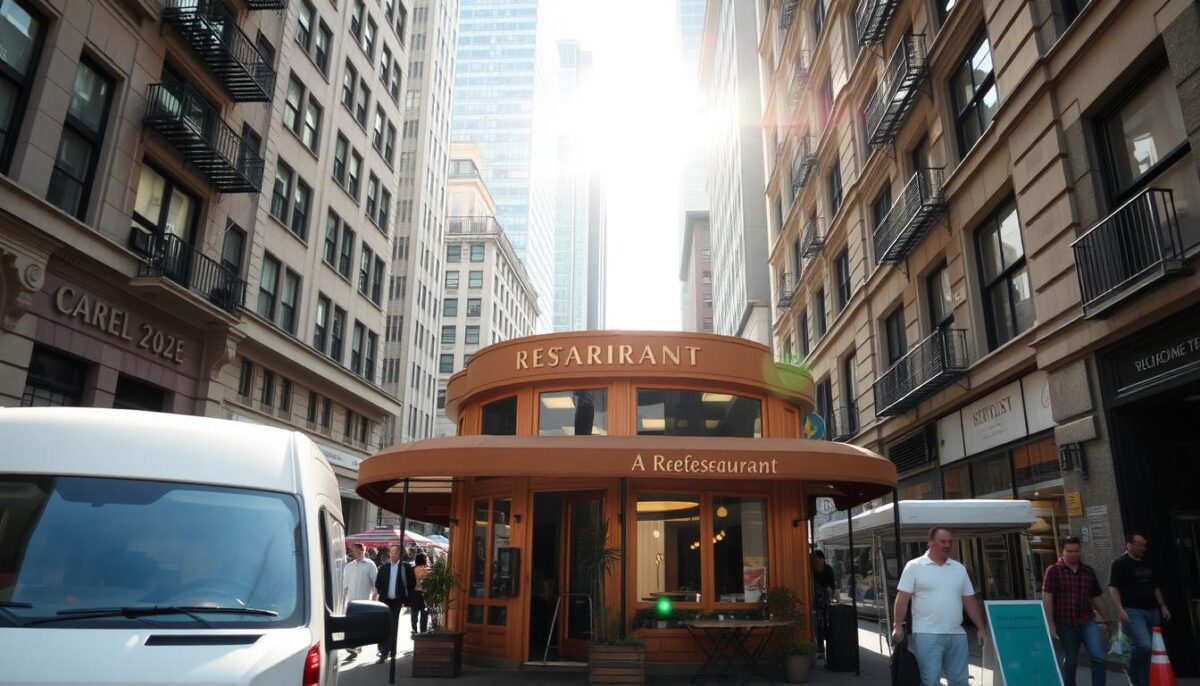
Designing Your Restaurant Layout
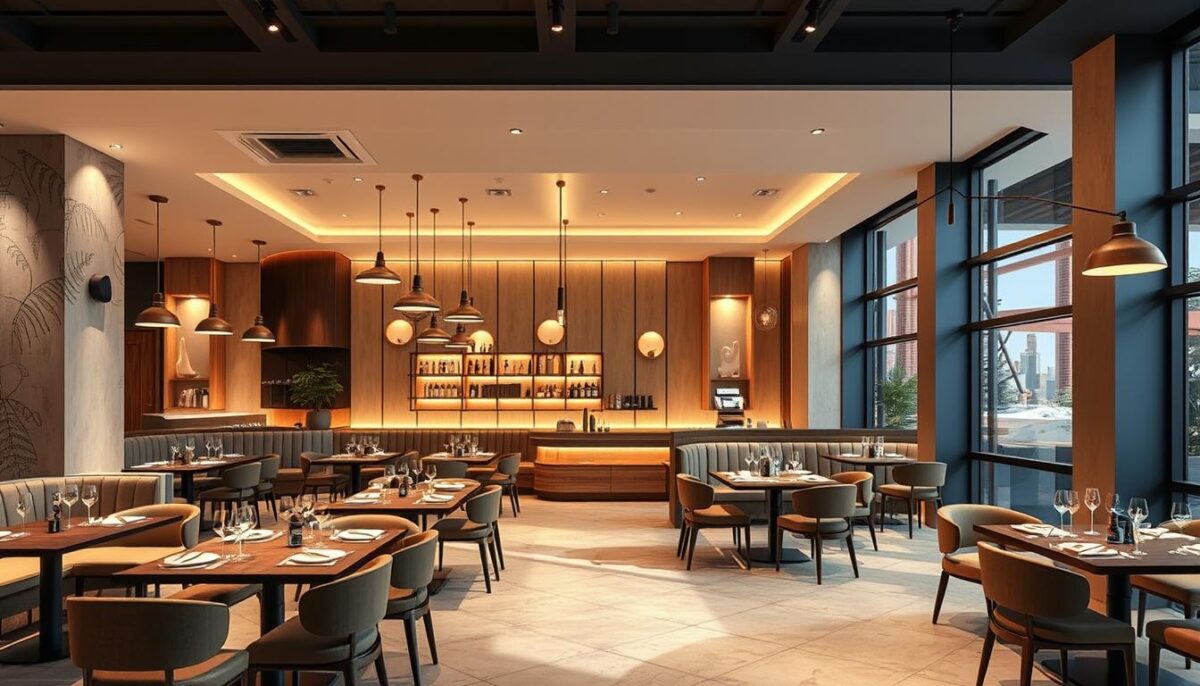
Creating an effective restaurant layout requires careful consideration of both aesthetics and functionality. A well-designed layout not only enhances the dining experience but also improves operational efficiency.
Front-of-House Design Principles
When designing the front-of-house area, it’s crucial to maximize space without overcrowding. Arrange your seating to ensure each table has a pleasant view and easy access for servers. Consider ambiance elements like lighting and decor, which should align with your restaurant’s theme and enhance the overall dining experience.
Efficient Kitchen Layout Planning
An efficient kitchen layout is vital for smooth operations. Plan the workflow to minimize movement and reduce wait times. Ensure that your kitchen design complies with health and safety regulations, and consider the workflow of your staff to optimize productivity.
Creating the Right Atmosphere
To create the right atmosphere, consider how design elements like color, texture, lighting, and sound work together. I’ll explain how to create a restaurant atmosphere that aligns with your concept and resonates with your target market. Selecting furniture, fixtures, and decor that reflect your brand identity while providing comfort and functionality is key.
- Understand how design elements work together to create a cohesive dining environment.
- Learn how to select furniture and decor that reflect your brand identity.
- Create an ambiance that encourages desired dining behaviors.
- Use lighting techniques to create the right mood at different times.
- Understand the impact of music selection and volume on dining behavior.
- Balance aesthetic considerations with practical needs like durability and cleanability.
Navigating Legal Requirements and Permits
The process of obtaining necessary licenses and permits can be daunting, but it’s a vital part of starting a business. As you navigate this complex landscape, understanding the various requirements will help ensure a smooth launch for your restaurant.
Essential Business Licenses
To operate a restaurant, you’ll need to secure various licenses and permits. These may include a general business license, food service permit, and employer identification number. The specific requirements vary by location, so it’s crucial to check with local authorities to determine the necessary documents for your establishment.
Health Department Regulations
Health department regulations play a critical role in ensuring your restaurant maintains high standards of cleanliness and food safety. This typically involves obtaining a food service permit and undergoing regular inspections. Compliance with these regulations not only protects your customers but also safeguards your business reputation.
Alcohol Licensing Considerations
If you plan to serve alcohol, you’ll need to navigate the process of obtaining an alcohol license. This involves understanding the different types of liquor licenses available, such as beer and wine or full liquor licenses, and their varying requirements. The application process typically includes background checks, public notices, and community hearings. “Liquor License – alcohol boosts sales!” is a common consideration for many restaurateurs. The costs associated with different types of alcohol licenses can be significant, so it’s essential to budget accordingly. Moreover, understanding responsible service requirements and staff training obligations will help you maintain compliance once licensed.
By carefully navigating these legal requirements and obtaining the necessary permits and licenses, you’ll be well on your way to establishing a successful and compliant restaurant business.
Developing a Profitable Menu
A well-designed menu is the backbone of any thriving restaurant, driving profitability and customer satisfaction. Crafting a menu that balances food costs with customer appeal is crucial for long-term success.
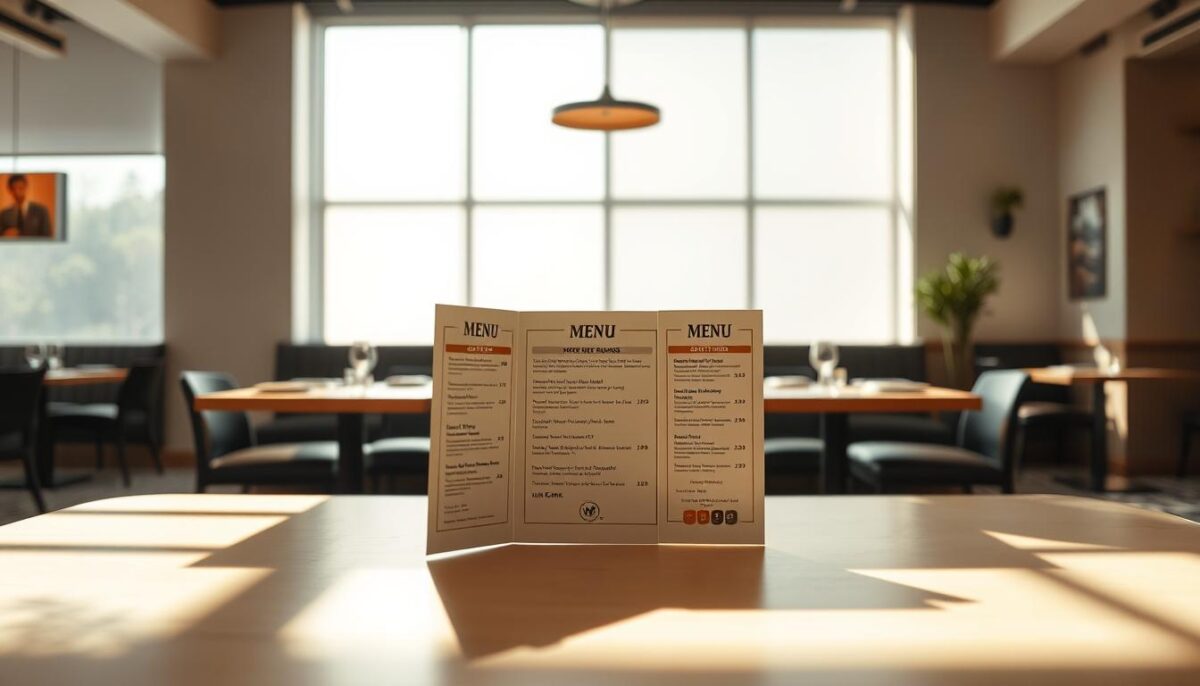
Menu Engineering Basics
Menu engineering involves analyzing the profitability of each menu item to maximize overall revenue. This process includes categorizing menu items based on their popularity and profitability, using techniques like the Boston Consulting Group matrix. By focusing on high-margin items and optimizing less profitable ones, restaurants can significantly improve their bottom line.
Pricing Strategies for Profitability
Effective menu pricing is a delicate balance between covering costs and maximizing profit. Key factors to consider include Cost of Goods Sold (COGS), Food Cost Percentage (typically around 28-35% of the selling price), Profit Margins, and Sales Forecasting. For instance, a dish with a COGS of $5 should be priced at least $17.85 to maintain a 28% food cost percentage.
“Pricing is not just about covering costs; it’s about understanding your customers’ perception of value,” says hospitality expert, Chef Thompson.
“A well-priced menu item not only covers its costs but also contributes to the overall profitability of the restaurant.”
Seasonal and Special Menu Considerations
Incorporating seasonal ingredients and special offerings into your menu can create excitement while managing food costs. Developing a core menu supplemented by seasonal specials allows you to maintain consistency while showcasing creativity and freshness. Plan seasonal menu changes that align with ingredient availability, weather patterns, and customer preferences. Use limited-time offers and chef’s specials to test new menu items before adding them permanently.
By understanding how to price seasonal items effectively and market seasonal menu changes, you can generate excitement and drive repeat visits, ultimately maximizing their impact on your restaurant’s profitability.
Sourcing Equipment and Supplies
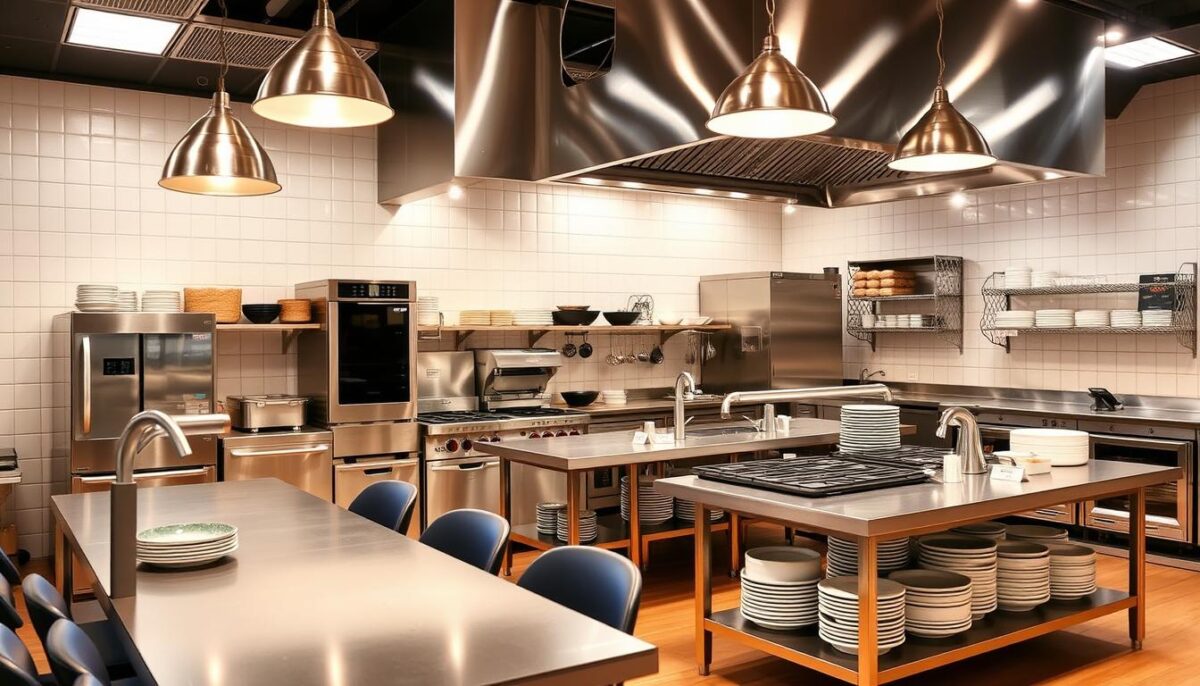
To ensure a smooth operation, restaurant owners must carefully source their equipment and supplies. This involves identifying reliable suppliers who can provide high-quality equipment and inventory. I’ll guide you through the process of finding and evaluating suppliers to help you build a robust supply chain.
Essential Kitchen Equipment
Your kitchen is the heart of your restaurant, and having the right equipment is crucial. Essential kitchen equipment includes commercial ovens, refrigerators, dishwashers, and cooking utensils. When selecting equipment, consider factors like durability, energy efficiency, and maintenance costs. For instance, a reliable commercial refrigerator is vital for storing perishable inventory.
Front-of-House Furnishings
The ambiance of your restaurant is significantly influenced by your front-of-house furnishings, including tables, chairs, and decor. These elements not only enhance the dining experience but also contribute to the overall aesthetic of your establishment. When choosing furnishings, balance style with durability and comfort. Consider the layout to ensure a smooth flow of customers and staff.
Finding Reliable Suppliers
Building a relationship with reliable suppliers is key to maintaining a consistent supply of equipment and inventory. Research potential suppliers, including broadline distributors and specialty vendors, to find those that meet your needs. Evaluate them based on product quality, pricing, delivery reliability, and customer service. Negotiating favorable terms, such as credit arrangements and delivery schedules, can also benefit your business. By developing strong relationships with suppliers, you can secure better pricing and priority service.
Building Your Restaurant Team
Building a strong restaurant team requires careful planning and effective management. As the minimum wage increases, so does the cost of labor, making it crucial to manage labor costs efficiently.
Key Positions to Fill
To build a comprehensive team, you need to identify and fill key positions. These include front-of-house staff like servers and hosts, back-of-house staff like chefs and dishwashers, and management personnel.
Effective Hiring Practices
Effective hiring practices are vital for finding the right candidates. This involves creating detailed job descriptions, conducting thorough interviews, and checking references to ensure you’re hiring qualified individuals who fit your restaurant’s culture.
Training and Retention Strategies
Training is a critical component of team development. Developing comprehensive training programs ensures consistent service standards and operational excellence. This includes creating detailed training materials like service manuals and recipe books.
- Implement effective onboarding processes to integrate new employees into your culture and operations.
- Develop career advancement paths to motivate employees and reduce turnover.
- Create a positive work environment that fosters employee satisfaction and loyalty.
- Implement fair scheduling practices and competitive compensation structures to attract and retain quality staff.
By focusing on these strategies, you can build a strong, efficient team that supports your restaurant’s success and enhances overall management.
Creating a Marketing Strategy to Start a Restaurant Step-by-Step
Crafting amarketing strategytailored to your restaurant’s unique needs is key to its success. A well-planned strategy helps create buzz, drives customer engagement, and sets your restaurant up for long-term success.
Pre-Opening Marketing Tactics
Before your restaurant opens, it’s essential to build anticipation and excitement. Utilizecontent marketingby creating engaging videos, blogs, and social media reels that give potential customers a sneak peek into your restaurant’s ambiance and menu offerings. Leverage email marketing by creating a newsletter that updates subscribers on your progress and offers exclusive promotions. Boosted social posts on platforms like Facebook, Instagram, and LinkedIn can also help increase your online presence.
Grand Opening Promotion Ideas
On your grand opening day, make a lasting impression with creative promotions. Consider hosting a soft opening for influencers and local press to generate buzz. Offer limited-time discounts or special deals to attract a large crowd. Collaborate with food delivery and order apps like Uber Eats and DoorDash to expand your reach.
Ongoing Marketing Efforts
After the grand opening, maintain momentum with ongoing marketing efforts. Implement a customer relationship management (CRM) system to track guest preferences and tailor your marketing communications. Develop loyalty programs that encourage repeat visits and increase customer lifetime value. Manage and respond to online reviews on platforms like Google, Yelp, and OpenTable to maintain a positive reputation. Analyze key performance indicators like customer acquisition cost and return on marketing investment to refine your marketing strategy.
By following these steps and continually assessing your marketing efforts, you can create a robust marketing strategy that drives success for your restaurant.
Setting Up Efficient Operations Systems

Efficient operations are the backbone of any thriving restaurant business. To achieve this, you need to invest in the right tools and systems, such as a reliable restaurant POS system and employee timesheets.
Point of Sale and Management Software
A robust POS system is essential for managing transactions, tracking inventory, and analyzing sales data. When selecting a POS system, consider one that integrates with your existing management software to streamline operations.
Inventory Management Procedures
Effective inventory management is critical to minimizing waste and maximizing profitability. Implementing a systematic approach to tracking inventory levels and ordering supplies will help you maintain optimal stock levels.
Service Standards and Protocols
Developing comprehensive service standards and protocols ensures consistent guest experiences across all shifts and staff members. I’ll guide you through creating detailed service sequences for different dining scenarios, establishing clear expectations for guest interactions, and developing systems for handling special requests and dietary restrictions.
To maintain high service standards, it’s crucial to implement quality control measures, document service protocols in training materials, and continuously refine your approach based on guest feedback and operational efficiency.
Planning Your Grand Opening
As I prepare to launch my restaurant, the grand opening is a critical moment that requires meticulous planning to create a lasting experience. This event sets the tone for my restaurant’s reputation, making it crucial to get it right.
Timeline for Launch Preparation
Creating a detailed timeline is essential to ensure that everything is in place for the grand opening. This involves planning and executing various tasks over a set period, managing my time effectively to meet the launch date. By doing so, I can ensure a smooth opening day and a great experience for my initial guests.
Staff Training for Opening Day
Training my staff is vital to the success of the grand opening. I need to ensure that they are well-prepared to handle the time pressures and potential chaos of the first day. Effective training will enable them to provide excellent service, enhancing the overall experience for my guests.
Creating a Memorable First Impression
To create a lasting impression, I must focus on delivering exceptional service and an outstanding dining experience. This involves paying attention to every detail, from the ambiance to the menu, and ensuring that my staff are friendly and attentive. By managing my time wisely and being prepared, I can make a positive impact on my guests from the start.
Keys to Long-Term Restaurant Success
To ensure your restaurant thrives in the long term, it’s crucial to focus on key factors that drive sustained success. The restaurant industry is highly competitive, with approximately 60% of establishments failing within the first year. Understanding the common pitfalls such as an undefined restaurant concept, poor employee management, and insufficient start-up capital can help you navigate these challenges.
Maintaining quality and consistency in food and service is essential for building a loyal customer base. This involves developing systems for continuous improvement through regular evaluation of menu performance, service standards, and financial metrics. By doing so, you can identify areas for improvement and implement changes that enhance the overall dining experience.
Building a culture of excellence within your restaurant is vital. This culture should persist even as staff changes and your business evolves. Strategies for staying relevant in a changing market include menu innovation, concept refreshes, and adaptation to emerging trends. Effective cash flow management and building financial reserves will also help your restaurant weather seasonal fluctuations and unexpected challenges.
Successful restaurants balance tradition and innovation to maintain customer interest while preserving their core identity. As your concept proves itself, understanding how to scale your business through expansion, additional locations, or brand extensions can provide growth opportunities. Leveraging technology to improve operational efficiency and enhance the guest experience is also crucial.
Building and maintaining relationships with key stakeholders, including loyal customers, staff, suppliers, and community partners, is essential for long-term success when starting a restaurant. Staying personally engaged and passionate about your restaurant business helps avoid burnout and maintains the entrepreneurial spirit that drove your initial success.
Preparing for and navigating industry disruptions, from economic downturns to changing consumer preferences, will help ensure your restaurant’s longevity. Finally, developing an exit strategy that maximizes the value of your restaurant business is crucial when you’re ready to move on to your next venture.
FAQ
What are the most significant costs associated with opening a restaurant?
The most significant costs include initial investment requirements such as equipment, lease or property purchase, inventory, and staffing expenses. Ongoing operational expenses like food costs, labor, marketing, and utilities also play a crucial role.
How do I determine the ideal location for my restaurant?
To determine the ideal location, consider factors like foot traffic, accessibility, competition, and demographics. Evaluating these elements will help you choose a spot that aligns with your target market and concept.
What type of licenses and permits are required to open a restaurant?
Essential licenses include business licenses, health department permits, and potentially liquor licenses, depending on your concept. Research local regulations to ensure compliance.
How do I create a profitable menu?
To create a profitable menu, focus on menu engineering basics like pricing strategies, food costs, and customer preferences. Consider seasonal and special menu offerings to keep your menu fresh and appealing.
What are some effective marketing strategies for a new restaurant?
Pre-opening marketing tactics like social media promotion and email marketing can generate buzz. Grand opening promotion ideas, such as hosting an event or offering limited-time discounts, can also attract customers. Ongoing marketing efforts, including loyalty programs and community engagement, help maintain a loyal customer base.
How do I manage inventory effectively?
To manage inventory effectively, implement inventory management procedures like tracking inventory levels, monitoring sales trends, and optimizing ordering schedules. This helps minimize waste and maximize profitability.
What are the key elements of a successful restaurant business plan?
A comprehensive business plan should include an executive summary, company overview, market and competitor analysis, financial projections, and funding requirements. This will serve as a roadmap for your restaurant’s success.
How do I secure funding for my restaurant?
Explore traditional funding options like loans and investors, as well as alternative financing methods like crowdfunding. Prepare a solid business plan and financial projections to present to potential lenders or investors.



